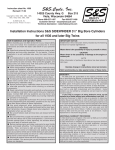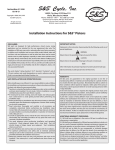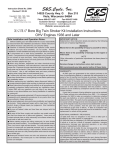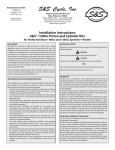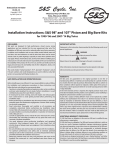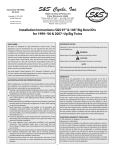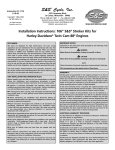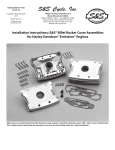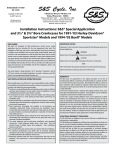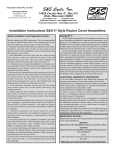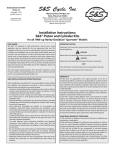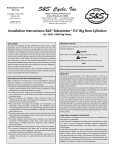Download S&S® Cycle, Inc.
Transcript
2-18-10 S&S Cycle, Inc Copyright © 2009 by S&S® Cycle, Inc. Phone: 608-627-1497 • Fax: 608-627-1488 Instruction 106-6072 ® . 14025 Cty Hwy G, PO Box 215 Viola, Wisconsin 54664 Technical Service Phone: 608-627-TECH (8324) Technical Service Email: [email protected] Website: www.sscycle.com All rights reserved. Printed in the U.S.A. Installation Instructions for S&S® Forged Pistons DISCLAIMER: S&S parts are designed for high performance, closed course, racing applications and are intended for the very experienced rider only. The installation of S&S parts may void or adversely affect your factory warranty. In addition such installation and use may violate certain federal, state, and local laws, rules and ordinances as well as other laws when used on motor vehicles used on public highways, especially in states where pollution laws may apply. Always check federal, state, and local laws before modifying your motorcycle. It is the sole and exclusive responsibility of the user to determine the suitability of the product for his or her use, and the user shall assume all legal, personal injury risk and liability and all other obligations, duties, and risks associated therewith. The words Harley®, Harley-Davidson®, H-D®, Sportster®, Evolution®, and all H-D part numbers and model designations are used in reference only. S&S Cycle is not associated with Harley-Davidson, Inc. SAFE INSTALLATION AND OPERATION RULES: Before installing your new S&S part it is your responsibility to read and follow the installation and maintenance procedures in these instructions and follow the basic rules below for your personal safety. Gasoline is extremely flammable and explosive under certain conditions and toxic when breathed. Do not smoke. Perform installation in a well ventilated area away from open flames or sparks. If motorcycle has been running, wait until engine and exhaust pipes have cooled down to avoid getting burned before performing any installation steps. Before performing any installation steps disconnect battery to eliminate potential sparks and inadvertent engagement of starter while working on electrical components. Read instructions thoroughly and carefully so all procedures are completely understood before performing any installation steps. Contact S&S with any questions you may have if any steps are unclear or any abnormalities occur during installation or operation of motorcycle with a S&S part on it. Consult an appropriate service manual for your motorcycle for correct disassembly and reassembly procedures for any parts that need to be removed to facilitate installation. Use good judgment when performing installation and operating motorcycle. Good judgment begins with a clear head. Don’t let alcohol, drugs or fatigue impair your judgment. Start installation when you are fresh. Be sure all federal, state and local laws are obeyed with the installation. For optimum performance and safety and to minimize potential damage to carb or other components, use all mounting hardware that is provided and follow all installation instructions. Motorcycle exhaust fumes are toxic and poisonous and must not be breathed. Run motorcycle in a well ventilated area where fumes can dissipate. •• •• •• •• •• •• •• •• •• IMPORTANT NOTICE: Statements in this instruction sheet preceded by the following words are of special significance. WARNING Means there is the possibility of injury to yourself or others. CAUTION Means there is the possibility of damage to the part or motorcycle. NOTE Other information of particular importance has been placed in italic type. S&S recommends you take special notice of these items. WARRANTY: All S&S parts are guaranteed to the original purchaser to be free of manufacturing defects in materials and workmanship for a period of twelve (12) months from the date of purchase. Merchandise that fails to conform to these conditions will be repaired or replaced at S&S’s option if the parts are returned to us by the purchaser within the 12 month warranty period or within 10 days thereafter. In the event warranty service is required, the original purchaser must call or write S&S immediately with the problem. Some problems can be rectified by a telephone call and need no further course of action. A part that is suspect of being defective must not be replaced by a Dealer without prior authorization from S&S. If it is deemed necessary for S&S to make an evaluation to determine whether the part was defective, a return authorization number must be obtained from S&S. The parts must be packaged properly so as to not cause further damage and be returned prepaid to S&S with a copy of the original invoice of purchase and a detailed letter outlining the nature of the problem, how the part was used and the circumstances at the time of failure. If after an evaluation has been made by S&S and the part was found to be defective, repair, replacement or refund will be granted. ADDITIONAL WARRANTY PROVISIONS: (1) S&S shall have no obligation in the event an S&S part is modified by any other person or organization. (2) S&S shall have no obligation if an S&S part becomes defective in whole or in part as a result of improper installation, improper maintenance, improper use, abnormal operation, or any other misuse or mistreatment of the S&S part. (3) S&S shall not be liable for any consequential or incidental damages resulting from the failure of an S&S part, the breach of any warranties, the failure to deliver, delay in delivery, delivery in non-conforming condition, or for any other breach of contract or duty between S&S and a customer. (4) S&S parts are designed exclusively for use in Harley-Davidson® and other American v-twin motorcycles. S&S shall have no warranty or liability obligation if an S&S part is used in any other application. GENERAL INFORMATION 1- For maximum piston and ring life, fit pistons using close fit dimensions. Close fit requires absolute adherence to new engine break-in as described on page 6. 2- For immediate drag strip use, fit pistons using loose fit dimensions. Break in rings and pistons with 50 easy miles if possible. Piston and ring life will be reduced with loose fit dimensions. 3- Measure all pistons at widest point across thrust face, perpendicular to wristpin hole. Several measurements should be taken to locate widest point. Typically, this will be at bottom of piston skirt for pre-1984 big twins, and approximately 1⁄2" below level of wristpin hole in pistons for Harley-Davidson® Evolution® and Twin Cam 88® engines. If pre-1984 piston is notched for placement in rear cylinder, use measurement directly above notch for skirt measurement. 4- S&S® recommends #220-#280 grit stone for final honing of stock bore and Sidewinder®, S&S T124 and S&S big bore cylinders. 5- Follow procedure recommended in Harley-Davidson® service manual for boring and honing stock bore big twin and Twin Cam 88® cylinders. Follow instructions included with S&S Cylinder Torque Plate Kit when boring and honing S&S 35⁄8" or 4", 41⁄8" bore cylinders. Torque plates must be used to simulate compressive stress in an assembled engine. Cylinders will distort if torque plates are not used. CAUTION Failure to follow instructions and perform required clearancing, installation and/or break-in procedures may result in damage to pistons and/or other engine components not covered under warranty. 2 SET PART NUMBER DESCRIPTION PART # STAMPED ON PISTON CLOSE FIT LOOSE FIT OLD S&S PN'S THAT ARE SUPERCEDED 106-5495 Piston Set 37/16" Std, LC, Forged, .791" WP, 1936-'84 bt 106-5491 .0035" to .004" .0045" to .0055" 92-2500 92-2510 106-5496 Piston Set 37/16" +.010", LC, Forged, .791" WP, 1936-'84 bt 106-5492 .0035" to .004" .0045" to .0055" 92-2501 92-2511 106-5497 Piston Set 37/16", +.020", LC, Forged, .791" WP, 1936-'84 bt 106-5493 .0035" to .004" .0045" to .0055" 92-2502 92-2512 106-5498 Piston Set 37/16", +.030", LC, Forged, .791" WP, 1936-'84 bt 106-5494 .0035" to .004" .0045" to .0055" 92-2503 92-2513 106-5773 Piston Set 37/16", +.040", LC, Forged, .791" WP, 1936-'84 bt 106-5774 .0035" to .004" .0045" to .0055" 92-2504 92-2514 106-5503 Piston Set 37/16", Standard, HC, .791" WP, 1936-'84 bt 106-5499 .0035" to .004" .0045" to .0055" 106-5504 Piston Set 37/16", +.010", HC, .791" WP, 1936-'84 bt 106-5500 .0035" to .004" .0045" to .0055" 106-5505 Piston Set 37/16", +.020", HC, .791" WP, 1936-'84 bt 106-5501 .0035" to .004" .0045" to .0055" 106-5506 Piston Set 37/16", +.030", HC, .791" WP, 1936-'84 bt 106-5502 .0035" to .004" .0045" to .0055" 106-5775 Piston Set 37/16", +.040", HC, .791" WP, 1936-'84 bt 106-5776 .0035" to .004" .0045" to .0055" 106-5511 Piston Set 31/2", Standard, LC, .791" WP, 1936-'84 bt 106-5507 .0035" to .004" .0045" to .0055" 92-2606 92-2616 106-5512 Piston Set 31/2", +.010", LC, .791" WP, 1936-'84 bt 106-5508 .0035" to .004" .0045" to .0055" 92-2607 92-2617 106-5513 Piston Set 31/2", +.020", LC, .791" WP, 1936-'84 bt 106-5509 .0035" to .004" .0045" to .0055" 92-2608 92-2618 106-5514 Piston Set 31/2" +.030", LC, .791" WP, 1936-'84 bt 106-5510 .0035" to .004" .0045" to .0055" 92-2609 92-2619 106-5519 Piston Set 31/2", Standard, HC, .791" WP, 1936-'84 bt 106-5515 .0035" to .004" .0045" to .0055" 92-2506 92-2516 106-5520 Piston Set 31/2", +.010", HC, .791" WP, 1936-'84 bt 106-5516 .0035" to .004" .0045" to .0055" 92-2507 92-2517 106-5521 Piston Set 31/2", +.020", HC, .791" WP, 1936-'84 bt 106-5517 .0035" to .004" .0045" to .0055" 92-2508 92-2518 106-5522 Piston Set 31/2", +.030", HC, .791" WP, 1936-'84 bt 106-5518 .0035" to .004" .0045" to .0055" 92-2509 92-2519 106-5527 Piston Set 37/16" x 43/4", Std, HC, .791" WP, 1936-'84 bt 106-5523 .0035" to .004" .0045" to .0055" 92-2800 92-2720 92-2730 93-2900 106-5528 Piston Set 37/16" x43/4", +.010", HC, .791" WP, 1936-'84 bt 106-5524 .0035" to .004" .0045" to .0055" 92-2801 92-2721 92-2731 93-2901 106-5529 Piston Set 37/16" x 43/4", +.020", HC, .791" WP, 1936-'84 bt 106-5525 .0035" to .004" .0045" to .0055" 92-2802 92-2722 92-2732 93-2902 106-5530 Piston Set 37/16" x 43/4", +.030", HC, .791" WP, 1936-'84 bt 106-5526 .0035" to .004" .0045" to .0055" 92-2803 92-2723 92-2733 93-2903 106-5777 Piston Set 37/16" x 43/4", +.040", HC, .791" WP, 1936-'84 bt 106-5783 .0035" to .004" .0045" to .0055" 92-2804 92-2724 92-2734 93-2904 106-5778 Piston Set 37/16" x 43/4", +.050", HC, .791" WP, 1936-'84 bt 106-5784 .0035" to .004" .0045" to .0055" 92-2805 92-2725 92-2735 93-2905 106-5779 Piston Set 37/16" x 43/4", +.060", HC, .791" WP, 1936-'84 bt 106-5785 .0035" to .004" .0045" to .0055" 92-2806 92-2726 92-2736 93-2906 106-5780 Piston Set 37/16" x 43/4", +.070", HC, .791" WP, 1936-'84 bt 106-5786 .0035" to .004" .0045" to .0055" 92-2807 92-2727 92-2737 93-2907 106-5781 Piston Set 37/16" x 43/4", +.080", HC, .791" WP, 1936-'84 bt 106-5787 .0035" to .004" .0045" to .0055" 92-2808 92-2728 92-2738 93-2908 106-5782 Piston Set 37/16" x 43/4", +.090", HC, .791" WP, 1936-'84 bt 106-5788 .0035" to .004" .0045" to .0055" 92-2809 92-2729 92-2739 93-2909 106-5535 Piston Set 35/8" Standard, HC, .791" WP, 1936-'84 bt 106-5531 .0035" to .004" .0045" to .0055" 92-1800 92-1830 92-1840 92-1620 92-1630 92-1640 106-5536 Piston Set 35/8" +.010", HC, .791" WP, 1936-'84 bt 106-5532 .0035" to .004" .0045" to .0055" 92-1801 92-1831 92-1841 92-1621 92-1631 92-1641 106-5537 Piston Set 35/8" +.020", HC, .791" WP, 1936-'84 bt 106-5533 .0035" to .004" .0045" to .0055" 92-1802 92-1832 92-1842 92-1622 92-1632 92-1642 106-5538 Piston Set 35/8" +.030", HC, .791" WP, 1936-'84 bt 106-5534 .0035" to .004" .0045" to .0055" 92-1803 92-1833 92-1843 92-1623 92-1633 92-1643 106-5789 Piston Set 35/8" +.060", HC, .791" WP, 1936-'84 bt 106-5790 .0035" to .004" .0045" to .0055" 92-1806 92-1836 92-1846 92-1626 92-1636 92-1646 106-5542 Piston Set 33/16" +.010", HC, .791" WP, 1972-'85 xl 106-5539 .0035" to .004" .0045" to .0055" 92-3701 106-5543 Piston Set 33/16" +.020", HC, .791" WP, 1972-'85 xl 106-5540 .0035" to .004" .0045" to .0055" 92-3702 106-5544 Piston Set 33/16" +.030", HC, .791" WP, 1972-'85 xl 106-5541 .0035" to .004" .0045" to .0055" 92-3703 106-5791 Piston Set 33/16" +.060", HC, .791" WP, 1972-'85 xl 106-5792 .0035" to .004" .0045" to .0055" 92-3706 106-5548 Piston Set 31/2" Standard, DD, .792" WP, 883 to 1200 conversion,1986-up xl 106-5545 .0025" to .0030" .0035 to .0045" 92-2446 106-5549 Piston Set 31/2", +.010", DD, .792" WP, 883 to 1200 conversion, 1986-up xl 106-5546 .0025" to .0030" .0035 to .0045" 92-2447 106-5550 Piston Set 31/2", +.020", DD, .792" WP, 883 to 1200 conversion, 1986-up xl 106-5547 .0025" to .0030" .0035 to .0045" 92-2448 106-5554 Piston Set 31/2", Standard, FD, .792" WP, 1984-'99 bt 106-5551 .0025" to .0030" .0035 to .0045" 92-2426 106-5555 Piston Set 31/2", +.010", FD, .792" WP, 1984-'99 bt 106-5552 .0025" to .0030" .0035 to .0045" 92-2427 106-5556 Piston Set 31/2", +.020", FD, .792" WP, 1984-'99 bt 106-5553 .0025" to .0030" .0035 to .0045" 92-2428 106-5793 Piston Set 31/2", +.030", FD, .792" WP, 1984-'99 bt 106-5794 .0025" to .0030" .0035 to .0045" 92-2429 3 PISTON INSTALLATION Picture 1 NOTE: Pistons may have piston to piston clearance on both the front and rear. The notches must face each other. Pistons for pre-1984 application have no wristpin offset and can be installed in the front or rear. Pistons for 1984-up applications should be installed according to the marks on the top of the piston. 1- Check all installations for minimum of .060" clearance between pistons at closest point near bottom of stroke. 2- Check all installations for minimum of .060" clearance between pistons and flywheels at bottom of stroke. Replacement pistons may or may not have adequate clearance. Compare replacement pistons with ones being replaced and make corrections accordingly. NOTE: In all cases it is the engine builder's responsibility to confirm proper clearances when assembling an engine. This is especially critical with performance components such as higher compression pistons and high lift camshafts. In addition to clearances mentioned, .060" valve-to-piston clearance must be confirmed. CAUTION Failure to establish proper clearances can result in severe engine damage not covered under warranty. WRISTPIN RETAINER INSTALLATION NOTE: Thoroughly clean wristpin before installation, paying particular attention to bore. Pass clean, lint-free cloth back and forth through wristpin bore several times to insure removal of contaminants. 1- If wristpin clips are used, insure that groove in piston is free of burrs and foreign matter. 2- Round "wire" style clips identical to and interchangeable with stock Harley-Davidson® Evolution® clips. Round wire clips require wristpins with specially chamfered ends. Install wire clips using procedure recommended in a Harley-Davidson® service manual. End of clip must rest over notch in piston below wristpin hole to allow removal of clip in future. Be sure clip is fully seated in groove. RING INSTALLATION 1- Ring widths on some piston series have changed from time to time. Part numbers of rings originally supplied with pistons should be recorded for future reference in the event replacement rings are required. 2- The majority of ring kits presently supplied by S&S® contain a moly faced top ring, a cast, reverse torsion second ring, and a three piece oil ring. This may be confirmed as follows: A- Top compression ring has a gray finish that is relatively light in color, and may or may not have a slight bevel along the inner edge. It has no dot or other identifying mark. The light color can best be recognized by comparing compression rings to each other beneath a good light. Install light colored ring without dot in top groove, bevel up. If there is no bevel, ring can be installed either side up. B- Second compression ring has a darker, charcoal gray finish and slight bevel along inner surface. This ring has a dot. See Figure 1. Install in second or middle groove with dot up. C- Oil rings are three piece type with two rails and one expander. Do not shorten expander for any reason! Installation is straightforward with one rail placed above expander, other rail below expander. Rails may be shortened to correct gap, but burrs must be carefully removed. NOTE: In some cases, same expander is used for several bore sizes. Oversize rings will not necessarily have a larger expander. 4 Figure 1 •• •• Figure 2 Figure 3 CAUTION Failure to remove burrs may cause engine damage. Incorrect installation of rings may result in poor performance, excessive oil consumption or engine damage. 3- For ring kits in which section #2 above does not apply, compression rings may be of plain cast iron type, chrome faced cast iron type, moly faced cast type or chrome type. A- The most common combinations are: 1- Two chrome faced cast rings 2- One chrome faced cast ring & one plain cast ring. 3- One moly faced cast ring & one plain cast ring. B- Install as follows: 1- Chrome faced or moly faced ring always goes in top groove 2- Plain cast ring usually goes in second groove. Plain cast type is usually a reverse torsion ring distinguished by an inside diameter bevel on one side of ring and a "dot" or oversize mark on other side. See Figure 1 above. If two cast iron compression rings are supplied in a set, check to see if one is reverse torsion style ring with dot and bevel. Reverse torsion style ring always goes in second groove with dot up if present. C- The following rules apply to compression ring identification and placement. Rules are listed in order of priority. In other words, if both Rule #2 and Rule #4 apply, for example, Rule #2 will be followed and Rule #4 ignored. 1- Chrome or moly ring goes in top groove. 2- Cast iron regular or reverse torsion ring goes in second groove. 3- Any identifying "pip" marks, dots or oversize marks go to top of piston. 4- Ring with one dot goes in top groove, ring with two dots goes in second groove. 5- If both rings are identical and have one dot or two dots, either ring can go in either groove. 6- If ring has dot and inside diameter bevel, dot goes to top of piston. See Figure 1above. 7- If ring has no dot but does have inside diameter bevel, bevel goes to top of piston. See Figure 2 above. 8- If ring has no dots and no bevel, it can go either way. See Figure 3 above. 4- Ring Gap Measurements A- Compression ring end gap on big twins with 37/16", 31⁄2" and 35/8" bore is .014" to .022". B- End gap on all other compression rings is .016" to .024". C- Oil ring rail end gap on big twins with 37/16", 31⁄2" and 35/8" bore is .015" to .035". NOTE: In certain instances, the next oversize ring set may be supplied with pistons, for example + .060" oversize rings with +.050" pistons. In this case end gaps must be measured and rings filed as necessary. Ends must then be carefully deburred. CAUTION Failure to deburr rings may result in engine damage. 5- Install ring support rail in front piston so that the end gap is toward the rear of the cylinder (90° from wristpin). Install ring support rail on rear piston so that the end gap is toward front of the cylinder (90° from wristpin). 6- Ring Gap Placement A- Oil ring 1- Expander gap must be in center of thrust face (rear of piston), or 90° from wristpin. 2- Bottom rail gap should be approximately 1.5" or 45° to right of expander gap. 3- Top rail gap should be approximately 1.5" or 45° to left of expander gap. 5 NOTE: Confirm that ends of expander do not overlap during installation. Properly installed expander will appear larger than piston but will compress when cylinder installed. B- Top compression ring gap should be 135° or approximately 41⁄2" to left of oil expander gap. C- Second compression ring gap should be 135° or approximately 41⁄2" to right of oil expander gap. *NOTE: Fit wristpins at .0007" to .0014.” ENGINE BREAK-IN PROCEDURE NOTES: S&S® engines are designed for high performance and as such are not as tolerant of inadequate break-in. Correct break-in will assure longer engine life and will prevent unnecessary engine damage. Engine damage caused by improper break-in is not covered under the S&S warranty. If new pistons have not been installed, only steps A, B, and C are required. If new pistons have been installed, all break in steps are required. •• •• •• A- Initial start up. Run engine approximately one minute at 1250-1750 rpm. DO NOT crack throttle or subject to any loads during this period as head gaskets are susceptible to failure at this time. During this time check to see that oil pressure is normal, that oil is returning to the oil tank, and that no leaks exist. B- Shut off engine and thoroughly check for any leaks or other problems. Let engine cool to the touch C- After engine has cooled, start up again and allow the motor to build some heat. Engine should be run no longer than three to four minutes. When the cylinders become warm/hot to the touch (approximately 150°) shut the motor down and let it cool to room temp. Follow the same cautions as for the initial start-up, and continue to watch for problems. D- Repeat this procedure 3 or 4 times. Each successive time it should take slightly longer to warm up and you can increase the temp slightly each time (+10°). You can be more liberal each time with the rpm, gently vary rpm continuously from idle up to 2500 rpm in the final cycle. Don’t be too concerned with final carb settings at this time because idle speed and mixture cannot be correctly set until the motor reaches full operating temperature. The motor should not reach that temperature during these cycles. Do not allow engine temperature to become excessive. After the motor has cooled to room temperature for the final time you are ready to start the 500 mile engine break-in process. E- The first 50 miles are most critical for new rings and piston break-in. Engine damage is most likely to occur during this period. Keep heat down by not exceeding 2500 rpm. Avoid lugging the motor, riding in hot weather or in traffic. Vary the engine speed. Do not lug the engine. We recommend changing the oil at 50 miles. F- The next 500 miles should be spent running engine no faster than 3500 rpm or 60 mph. Avoid continuous steady speeds, and do not lug the engine. Vary engine rpm. We recommend changing the oil again at 500 miles. CAUTION Lugging or running engine prematurely at sustained high rpm may result in damage to pistons and other engine components. S&S® voids its guarantee if engine is not broken in properly. G- For the balance of the first 1000 miles the motor can be run in a normal but conservative manner. You can be more liberal with the rpm range and motorcycle can be operated at normal highway speeds. Avoid overheating or putting any hard strain on the engine: no drag racing, dyno runs, excessive speed, trailer towing or sidecar operation. H- After 1000 miles, verify carburetor jetting and adjustment. Change the engine oil. Motorcycle can now be operated normally. I- Have Fun! 6







